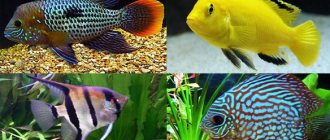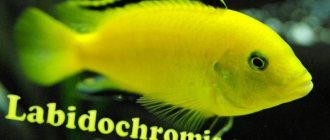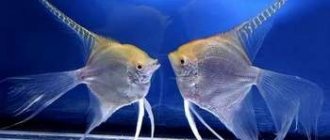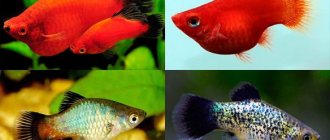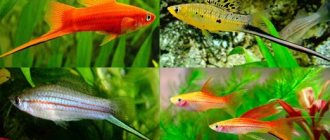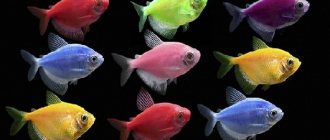A cichlid is a species aquarium that contains exclusively fish from the order Perciformes of the Cichlid family. In addition to their bright appearance, these pets have a wayward character and a high percentage of conflicts. To successfully launch a cichlid fish, you should familiarize yourself with the recommendations of experienced aquarists and special literature.
Aquarium parameters
Beginner aquarists are recommended to acquire an elongated aquarium with a volume of up to 120 liters. A large container is easier to maintain, and the aggression of cichlids will be more likely to dissipate in it. However, for large breeds, an aquarium of 200 liters or more is required, which can accommodate up to 4 fish. Water parameters depend on the specific type of cichlid fish. To begin with, it is better to purchase less sensitive pets.
The water in a cichlid aquarium should be slightly alkaline and slightly acidic 5.5-7, hardness 6-12°. The temperature should be as close as possible to the parameters of the fish’s natural habitat. Tap water is suitable for cichlids, but given the different water values in different regions, it is best to filter the water and let it sit for a while in a container with shells, corals and gravel. To normalize the acidity in an aquarium, the method of adding a phosphate buffer is often used.
Do not place the aquarium near windows or heating appliances. The best moderate lighting is achieved with fluorescent lamps. Experienced experts recommend changing water monthly with a quarter of the total volume. Be sure to equip the aquarium with a filter, compressor and heater. Only after all the necessary requirements have been met can you start launching the cichlid.
Return to content
In the wild, the Amur sleeper lives in eastern Russia, in the waters of the Amur and the rivers flowing into it, small lakes and creeks.
This is where another name for the fish came from - “Amur goby”. Under natural conditions, some individuals grow up to 20-22 cm, but in an aquarium, fish rarely reach 10-12 cm in length. The average size of an adult in a home aquarium is 8 cm. The large head with the lower lip protruded forward and the mouth slightly open determines the fish’s popular name. The round, thick, almost rigid body ends in a round caudal fin. The dorsal fin is double, with the rear fin in males being much larger than the front. The main background of the body is brownish-gray; large brown-black spots are scattered across it, forming a carpet pattern. During the spawning period in males, these spots become black, and the spaces between them form a complex pattern that glows in the reflected light with a bluish sheen. The pectoral fins of the Amur goby form a kind of suction cup, which allows this fish to attach to any surface with its help.
Amur gobies living in natural conditions are paler in color than their aquarium relatives. In addition, they are more sensitive to the oxygen content in the water.
Rotan is exceptionally unpretentious and undemanding; it lives well even in small cold-water aquariums (from a bucket for a couple of fish). Tolerates oxygen deficiency in water. In the wild, the Amur goby, like golden crucian carp, can withstand almost complete drying and freezing of water bodies, burying itself in silt.
There are no special requirements for keeping Perccottus glenii in a home aquarium, except that when decorating the aquarium internally, you should take into account that the goby loves shelter. The size of the container when keeping these fish is not critical, but it is desirable that there be at least 10 liters of water per individual. The presence of aquatic plants is also desirable. When kept in an aquarium, it should be taken into account that the Amur goby is a predatory fish that attacks other representatives of the aquarium fauna. There have been cases when these gobies attacked fish of other species that were not inferior to them in size. Rotans should absolutely not be placed in the same aquarium with small decorative fish. In a day or two, the Amur goby is capable of catching all small animals such as guppies and neons and simply gobbling them up.
These gobies are very voracious and in an aquarium they eat almost any live food (bloodworms, tubifex, etc.). In addition, they eat dry granulated food very well. When feeding Amur gobies with small fish, you can observe a peculiar hunting behavior of rotans. Having noticed the fish, rotan, with slow, almost imperceptible to the eye movements of the pectoral fins, without bending the body at all, begins to approach its prey. Swimming up to it at a distance of 8-10 cm, the rotan simultaneously rushes towards the prey with a sharp movement of the pectoral and caudal fins.
In home aquariums, rotans reproduce well. When the spring sun begins to warm the water and growing plants create good aeration in the aquarium, male rotans dress in mating plumage, become pugnacious, and begin to pursue females. Rotans spawn in an aquarium, attaching eggs to the inside of a shelter placed in the aquarium. The male carefully guards the eggs and the fry that hatch from them, attacking any fish that swims up to the nest and viciously destroying snails and other aquatic animals that find themselves near the nest.
It is advisable to place the newly born rotan fry (if you need them) in a separate container, because adult fish are not at all averse to feasting on the little ones. The fry feed on zooplankton and other small live food. With plenty of feeding, fish grow quite quickly.
Decor
The common belief that a cichlid is a naked aquarium with rocks and artificial plants is partly correct. Representatives of this family really like to dig up living plants and spawn on stones. But a caring aquarist will be able to arrange a picturesque design in the aquarium for his pets.
The cichlid acquires a special charm thanks to its massive decorative elements reminiscent of a rocky landscape. Caves, grottoes, broken amphorae will also add a fabulous feel, and driftwood overgrown with plants will perfectly complement the overall aquarium interior with its naturalness.
To divide the container into zones, you can use various decorations and correctly distribute the plants. In a cichlid tank, mounds of stones or driftwood will look especially good, which will also divide the territory for pairs of fish.
Return to content
Plants
Plants in a cichlid garden must certainly have endurance and the ability to quickly recover, otherwise they are in danger of rapid death. The main reason for the incompatibility of cichlids and plants is different water parameters. Many cichlids, due to their omnivorous nature, also eat plants, so the task of choosing suitable plants for a cichlid’s aquarium should be approached with special attention. Cichlids are not at all bothered by plants floating on the surface; they like to dig up those planted in the ground. Therefore, it is best to plant plants in pots.
The most common plants for cichlids include the following: Vallisneria tigris and gianta, Echinodorus, Aponogeton ulvoides, Cryptocoryne undulate, Hygrophila willow and polysperm, Brazilian pinnate, Monoselium, nymphea, ferns, Gymnocoronis, Limnophila ambulia. Among the groundcovers, it is optimal to choose dwarf saggitaria, and dwarf anubias can be planted on snags, since this plant grows rather slowly and does not attract the attention of cichlids.
Return to content
Priming
Registration of a cichlid should begin with the correct choice of soil. Depending on the type of fish, the soil is also selected. For medium-sized inhabitants, sand with a fraction size of 3-5 mm is suitable. This substrate is convenient for cleaning and retains organic particles well. The soil is laid out at a depth of 6-8 cm, which is perfect for planting plants in it. It is also necessary to take into account the color of the soil, which has a direct impact on the condition of the fish. For large cichlids, it is recommended to choose a larger and darker soil.
Return to content
Selection of fish
Fish from the cichlid family are divided into 3 types:
- originating from African rivers;
- native to Central America;
- from the Amazon.
African cichlids are considered the friendliest. In a 120 liter vessel you can place a pair of Haplochromis multicolor, a pair of parrots and a pair of butterflies in combination with four Ancistrus catfish.
From American cichlids, you can choose a pair of striped cichlases and Sedzhik cichlases, placing them next to a pair of hypostomuses.
An aquarium with Amazonian cichlids should be at least 200 liters. Angelfish can coexist in it with curviceps and maroni cancers. You can add a small group of ancistrus to them.
Return to content
Description of the species
The cichlid families belong to the order Perciformes and are distinguished by a wide variety of colors and shapes. They can be small in length - 2 centimeters and quite large - up to 91 centimeters, and some specimens up to one meter. They are found in fresh and brackish water, in Asia, Africa, and Latin America. Some species are on the verge of extinction.
Answering the question “how long do cichlids live”, with proper care, life expectancy can reach up to 10 years. There are bred fish with bodies artificially colored in unnatural colors, for example, pink, but such pigment does not last long and the health of the fish deteriorates. .
Launch
Fine sand is placed in the cichlid tank with African fish, and plants are planted densely. But there should also be enough space for swimming. Mounds of stones, caves and pots are used as decoration. In the right conditions, the fish will be able to spawn and thrive.
American cichlids have a more conflicting nature. These pets can do without plants, but if you choose live plants, it is better to opt for more hardy ones such as anubias and Java moss. Flat stones on which fish can lay eggs, and shelters in the form of caves and shells are suitable for decoration.
An aquarium with Amazons requires thickets of plants with free space for the fish to move around. Cryptocoryne and Echinodorus are suitable, since angelfish usually spawn on plant leaves. For other inhabitants you will need caves and stones.
Return to content
Stones in an aquarium with cichlids, which ones to choose?
When choosing stones for this type of aquarium like a cichlid. Worth considering as the best option. Irregularly shaped stones with a large number of ledges, crevices, and through passages. That is, the more different shelters there are in the stones, the better for the inhabitants. It is also easier to fasten such stones together without even using additional fasteners; due to the irregular shapes, by selecting the desired position, the stones can be securely fixed to each other. When using rounded stones or stones with straight, even edges. It is quite difficult to achieve a beautiful and at the same time stable composition. In such cases, the stones will have to be secured with something additional, for example using a special aquarium sealant. It is sold by aquarium companies and is sometimes available in stores. This composition for gluing stones is often used when building reefs in marine aquariums. They use it to glue live reef rocks.
Compatibility
There are many opinions about keeping cichlids together with other fish species. And one of the most possible ways of such a combination is a competent approach to the matter. An important rule is to plant cichlids at a younger age, and the rest of the fish, on the contrary, at a more mature age. It is necessary to take into account the aquarium volumes and swimming layers provided for each fish. Veiled cichlids should not be combined with aggressive and biting neighbors such as barbs, swordtails, goldfish, and cockerels. Small and slow fish such as neon and guppies will certainly feed large cichlids.
The cichlid is an amazing type of aquarium, the main feature of which is the combination of fish with a complex character, plants and its harmonious design. Maintaining such an aquarium requires a meticulous approach and compliance with the rules for its care. However, as a result, the owner of a cichlid will get great pleasure from enjoying the underwater fauna created with his own hands, as well as colorful pets with interesting habits.
Return to content
Aquarium fish Cichlids: maintenance and care
Breeders have bred a large number of species of Cichlids, differing from each other in appearance, body shape and habits. Fish can be painted in a wide variety of colors: white, pearlescent, blue, green, pink. Different species have their own patterns on the sides: longitudinal or transverse stripes, specks, dots. The body shape of different species is different: elongated, circular, flat. The character of the fish is also not the same; they can be quarrelsome and peaceful.
Caring for Cichlids is not too complicated, but it requires following some rules:
- the volume of the aquarium should be from 150-300 liters;
- be sure to provide grottoes, caves, houses so that the fish can hide;
- make sure that the constant water temperature is +20-28° C, but for some species the temperature can be from +28-30° C;
- acidity 6-8 pH;
- hardness from 5-15° dH;
- the water must be clean, partial replacement is necessary 2 times a week, the water should not be too hard;
- filter water, install an aeration system;
- It is better to make the aquarium a species one by placing a family of one male and several females there. You should not put several males of the same species into one aquarium; they will destroy each other.
You should not plant aquarium plants in the tank, the fish will tear them to pieces. It is worth giving preference to artificial bushes; it is better to pour sand on the bottom. A lid with artificial lighting should be installed on top; the light should be diffused and not too bright.
